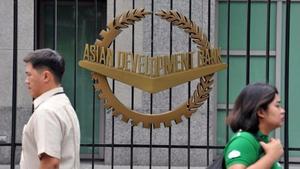 Pedestrians walk past a logo of the Asian Development Bank (ADB) displayed outside its headquarters in Manila, Philippines on Sept 2, 2010. (TED ALJIBE / AFP)
Pedestrians walk past a logo of the Asian Development Bank (ADB) displayed outside its headquarters in Manila, Philippines on Sept 2, 2010. (TED ALJIBE / AFP)
The Asian Development Bank cut economic growth forecasts for developing Asia, as the emergence of the Omicron variant and rising coronavirus infections globally show the pandemic is far from over.
The region’s gross domestic product will expand 7 percent this year, down a notch from the 7.1 percent forecast in September, the ADB said in its Asian Development Outlook Supplement released Tuesday.
Asia's GDP expansion will mark a course reversal from last year’s 0.1 percent contraction, and will moderate to 5.3 percent in 2022 - slower than the 5.4 percent previously estimated
The expansion will mark a course reversal from last year’s 0.1 percent contraction, and will moderate to 5.3 percent in 2022 - slower than the 5.4 percent previously estimated.
“Developing Asia is expected to sustain its strong rebound as envisaged in September,” the Manila-based lender said. Yet, the “recent emergence of the highly mutated Omicron coronavirus variant is a sobering reminder that further outbreaks remain a possibility,” it said.
ALSO READ: ADB cuts developing Asia growth outlook
India’s forecast is lowered to 9.7 percent for fiscal year that began April 1, 2021. Southeast Asia’s outlook has also been cut to 3 percent for 2021 amid expectations of slower growth in Malaysia and Vietnam.
New infection waves could reverse reopening in many nations, the ADB said. Travel restrictions also damp growth prospects for tourism-dependent economies, it said.
In addition, according to the supplement, regional inflation remains manageable, with the forecast revised down to 2.1 percent for 2021 and unchanged at 2.7 percent for 2022, which will allow monetary policy to stay supportive. Still, upside risks to inflation could prompt the US to tighten monetary policy earlier and trigger financial volatility.
READ MORE: ADB to support green recovery in ASEAN with funding platform
Most economies in developing Asia have ramped up their vaccine rollouts, but progress still varies considerably, the supplement noted.


